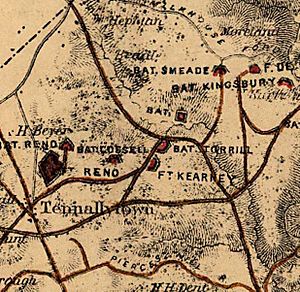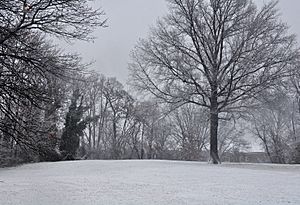Fort Reno Park facts for kids
Fort Reno Park is a cool park in the Tenleytown neighborhood of Washington, D.C. It's special because it has the highest natural point in the entire District of Columbia! This park was also the site of the only Civil War battle that happened right in Washington, D.C. That battle was called the Battle of Fort Stevens.
Contents
Building Fort Reno: A Civil War Defense
In August 1861, engineers decided to build a fort on the highest spot in Washington, D.C. This was to protect the city during the American Civil War. Soldiers from different groups helped build it.
At first, the fort was named Fort Pennsylvania. But in 1863, its name was changed to Fort Reno. This was to honor Major General Jesse L. Reno, a brave soldier who died in 1862. The land where the fort was built belonged to the Dyer family. Their farmhouse was even used as a headquarters for the army.
Fort Reno was one of many forts built around Washington to defend against the Confederate soldiers. It was quite large, with enough space for 27 cannons. It even had a powerful 100-pound Parrott gun. A tall signal tower was also built there. This tower helped send messages using flags or lights, as its high location was perfect for seeing far away. Eventually, Fort Reno became the biggest fort around Washington, with 12 heavy guns and about 3,000 soldiers.
Fort Reno During the Civil War
Fort Reno saw real action from July 10-12, 1864. During this time, Confederate General Jubal Early led about 22,000 soldiers to attack Washington. The Union Army had fewer defenders, only about 9,000 troops.
Fort Reno's lookouts were the first to spot the Confederate movement from Maryland. The main attack happened about 4 miles east of Fort Reno, at Fort Stevens. This battle is known as "The Battle of Fort Stevens". The Union Army won, successfully defending Washington, D.C.
After the war, the area around the fort became a "Freetown" for formerly enslaved people. Later, a large water reservoir was built there.
Fort Reno in the Cold War Era
During the Cold War, special buildings were put in place at Fort Reno. These were part of a secret plan called "Continuity of Government." This plan made sure the government could keep working even during a big emergency.
One large brick tower, which looks like a water tower, is actually a communications tower. It has living spaces for its crew inside. This tower was part of a network that connected the White House to other important sites, like "Site R" in Pennsylvania.
Fort Reno Park Today
Today, National Park Service takes care of Fort Reno. It's a great place for outdoor activities! The park has a baseball field, several tennis courts, and a community garden. There are also large grassy areas perfect for playing. However, the reservoir itself and the old sandstone building are not open to the public.
Many people gather at Fort Reno Park on the 4th of July. From the western side of the park, you can see amazing fireworks displays happening over nearby Maryland and Virginia.
Summer Concerts at Fort Reno
Fort Reno has hosted free summer concerts every year since 1968. These concerts started during a time of social change after the assassination of Martin Luther King Jr.
In 2014, there was a problem with the concert series. The National Park Service suddenly asked the organizers to pay for park police to be at every concert. This cost was too high for the concert budget, so the organizers had to cancel the shows. Many people were upset, and there was a lot of discussion online and in the news. Public officials stepped in to help. After a meeting, the concerts were back on for 2014!
In May 2008, Fort Reno Park was temporarily closed. Officials thought they found high levels of arsenic in the soil. A fence was put up around the park. But just two weeks later, the park reopened, and the fence was removed. It turned out the initial arsenic readings were a mistake.
The Highest Point in D.C.
The highest natural spot at Fort Reno is 409 feet (125 meters) above sea level. This is lower than the top of the Washington Monument, which is 555 feet (169 meters) tall.
A small metal disk in the ground marks this high point. The Highpointers Foundation is working with the National Park Service to put a sign near this marker. This will make it easier for visitors to find this special spot.



